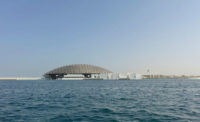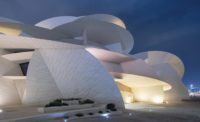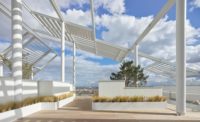This may come as a surprise: the Louvre Abu Dhabi is a subtle piece of architecture. In a booming city whose population has tripled in the last 20 years, where surreal landscapes mix with improbable towers, this museum has been over a decade in the making and is reputed to have a total price tag of over $1 billion. Its opening was attended by the Crown Prince Sheikh Mohammed bin Zayed and President Emmanuel Macron of France. So one might expect a bit more of a spectacle. And while there are spectacular moments, this is a work that reveals itself slowly.
There is, of course, the dome; 590 feet in diameter, it is giant. But Nouvel’s dome doesn’t shout. From a distance, its glimmering metallic finish almost blends with the rippling Persian Gulf waters it hovers above. It is squat. In fact, the entire building is very low and rather unassuming from the outside.
Then, there’s that water. “The sea is extraordinary,” said Nouvel during a preview of the building just before the museum opened to the public on November 11. “When you have this great asset, it’s like having a great card in a hand: you have to use it.” Like a built archipelago beside the shores of Saadiyat Island—where a larger cultural district containing museums by Norman Foster and Frank Gehry and a performance center by Zaha Hadid is planned—water winds in canals around the meandering cubic pavilions that make up the museum, which Nouvel modeled after a medina. Like a parasol, the dome covers nearly all of the 55 individual pavilions, almost half of which are galleries.
There is no grand entrance. After walking across the nondescript parking lot, you pass through oversized revolving doors and airportlike security before making your way through several boxy structures —all quite stark—past a large information desk, a ticketing area, and the museum shop. Only a glimpse of the dome’s underside is offered up to this point.
But then, as you come upon the plaza—what Nouvel refers to as an Arabian agora—the full splendor of the dome overhead confronts you. At first it looks unreal, like a dizzying mirage above your head, both immaterial and hulking at the same time. It is composed of eight layers of complex steel assemblies containing 7,850 unique stars—the largest of which are 43 feet wide—in a dense geometric latticework that allows only 1.8 percent perforation. When asked what was the hardest part of building the dome, senior construction manager Shehab Taha replied, “All of it.”
Nouvel was inspired by the fronds of the local date palm tree; his dome acts in a similar way to provide shade and dappled sunlight. The area beneath the dome, while completely exposed, is noticeably cooler than the sun-baked parking lot. Though there is virtually no rainfall in Abu Dhabi, should it happen, water would pass through the dome’s scant openings. There are no walls either. The dome sits on four piers, 360 feet apart and hidden within the pavilions, giving the impression that it is floating, and offering open, framed views of downtown Abu Dhabi’s skyline in the distance. A gentle breeze occasionally wafts through. Birds fly by. Insects flit about. “We didn’t want to do a building—we wanted to create a neighborhood,” says Hala Wardé, project architect and longtime Nouvel collaborator, who also heads her own firm.
Although the exteriors of the pavilions and their enclosing walls—clad in white, precast, high-performance fiber concrete panels—look like plain urban vernacular forms, the galleries within come as a surprise. They are lavish. Nouvel describes the experience, appropriately enough, as stepping into a palace.
Nouvel’s office designed the variously sized bronze-framed glass display cabinets, and pedestals whose bases are wrapped in a grayish-blue Belgian stone, which also comprises much of the flooring between galleries. Within the galleries, a distinct stone “carpet” defines the exhibition area, with a different stone corresponding to the collection on display—Italian marble for the Renaissance galleries, for instance. In some rooms, the 55-inch by 9-inch bronze-framed (and removable) floor tiles are boldly colored; others are deeply veined, and still others more muted. Overhead, an exquisite glass ceiling likewise delineates the display area below. Two superimposed layers of glazed tiles, variously textured with lines, dots, or waves, give the ceiling a subtle moiré effect. Inset between the tiles are custom-designed LED fixtures that Nouvel’s office developed with Italian lighting manufacturer Artemide. In some cases, a mirrorwalled skylight pierces the glass ceiling.
The art—a CliffsNotes representation of the Louvre’s encyclopedic collection, with such famous pieces as Édouard Manet’s The Fife Player and Jacques-Louis David’s Napoleon Crossing the Alps, as well as loans from other French institutions—is inventively hung. In one room, a long architectural frieze carved with Koranic verses (ca. 1200) is inset into a wall. A wood statue of Joseph of Arimathea from around the same time stands beside a veiled window, bathed in soft daylight. Exquisite gold jewelry shimmers within a dark-wood room-size case. Select gallery walls are lined with bronze panels. The diversity of materials and textures, masterfully handled here, enriches rather than competes with the art. It is all quite stunning, and a happy antidote to the generic white box of so many museum galleries. These no-expense spared interiors inspire awe in much the same way that the minimal plaza does with its dancing light and gentle pools of water.
As the first project of the much-hyped but much-delayed arts district to open on Saadiyat Island, the Louvre Abu Dhabi is enjoying the spotlight. But whether or not the other projects are ultimately realized (their fates remain unclear) the museum is, as its architect explains, not a building: it is instead a cultural oasis, very much of its place yet unlike anything else nearby—or, for that matter, anywhere.
Video courtesy EarthCam















Post a comment to this article
Report Abusive Comment